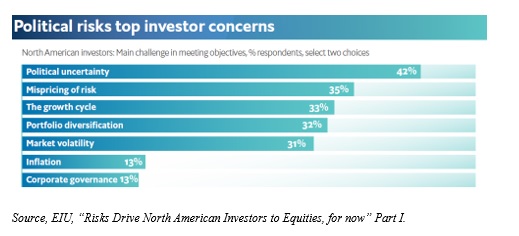
With the sponsorship of Franklin Templeton, The Economist Intelligence Unit (EIU) has surveyed 143 investing institutions in North America (part of the global sample of 571) in order to study recent shifts in their portfolio allocation, especially with an eye to the risks that concern them and the length of their time horizon.
In an accompanying press release, Kevin Plumberg, editor of the report, said: “U.S. political and regulatory risks appear to have moved to the foreground for a lot of North American institutional investors, and as a result many have found perhaps temporary refuge in rising stock markets.” This recourse to equities is tactical, not strategic, and these institutions (again in Plumberg’s words), remain “focused on the long-term goals as near-term risks evolve.”
Challenges
When North American investors were asked to select two out of seven possible risks as their “main challenge” in meeting their objectives, they responded thus:

The numbers reach 199% rather than 200%, presumably due to rounding.
An obvious question might be: Are risks increasing or decreasing over time, in recent months and years, in North America? But that would be too simple. The report begins with the assertion that the risk environment is “complex, neither very negative nor very positive.”
Focus
The administration of President Trump is “idiosyncratic” and appears to have only a very limited ability to enact legislation. The Federal Reserve wants to increase the federal funds target rate. Equity markets are near all-time highs, which makes many nervous (be worried when most are greedy, be greedy when most are worried, say the sages), the regulatory environment is uncertain and “disruptive technologies are having an impact on many industries.”
Nearly half of the institutions surveyed say they have become more focused on their long-term objectives in recent months (47%). Only 20% say they have increased their focus on the short term.









Leave A Comment